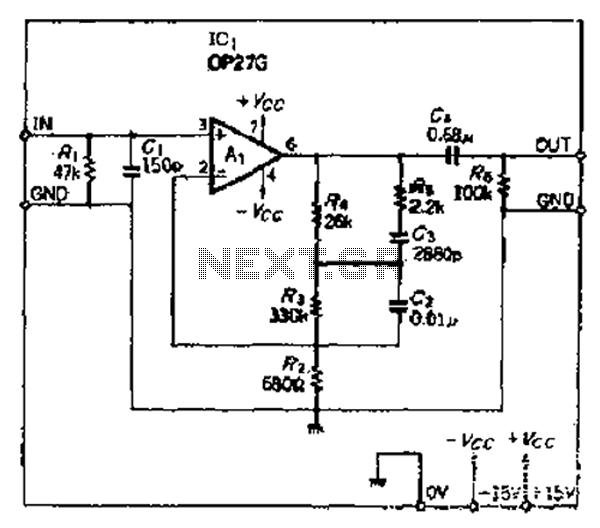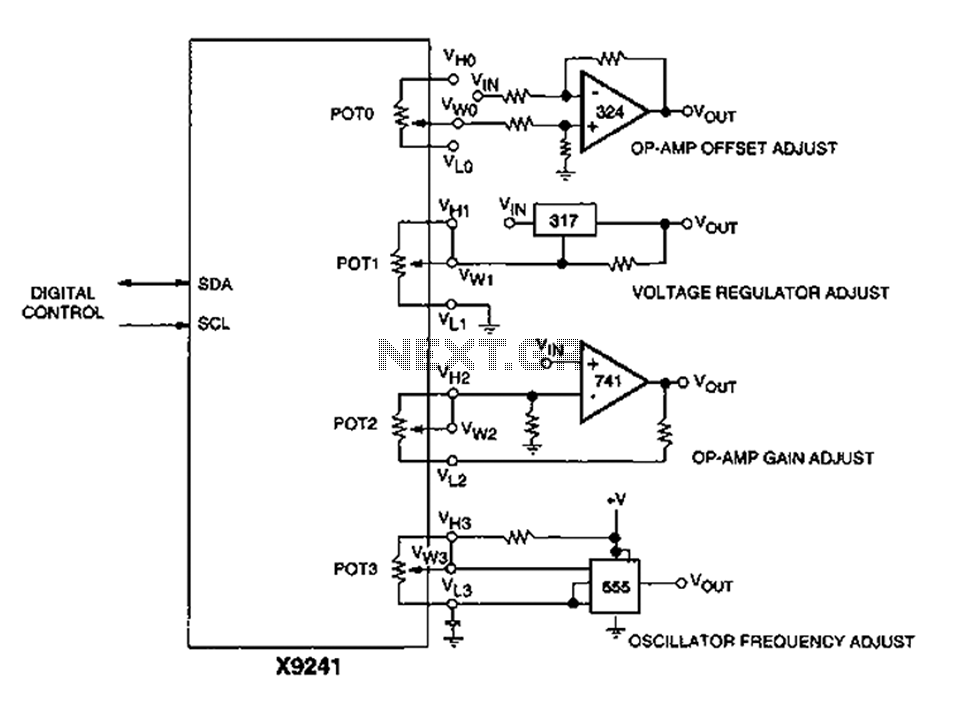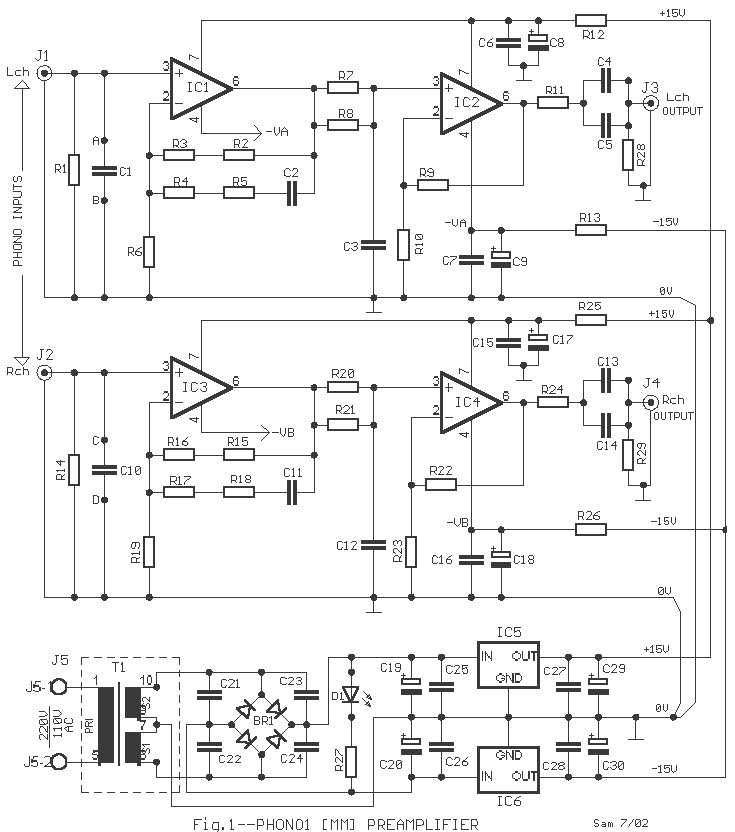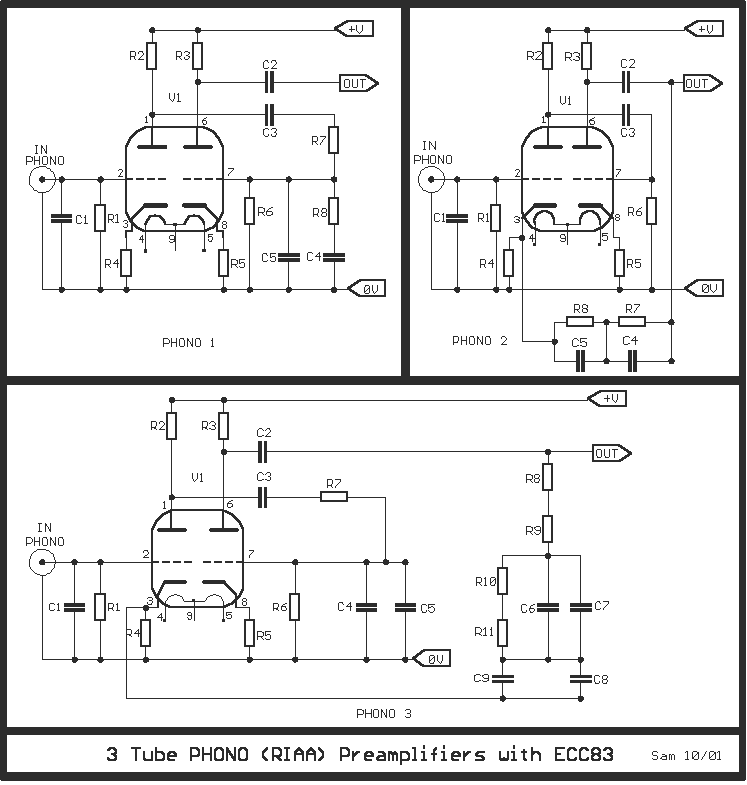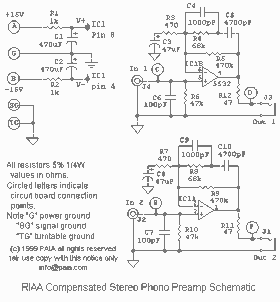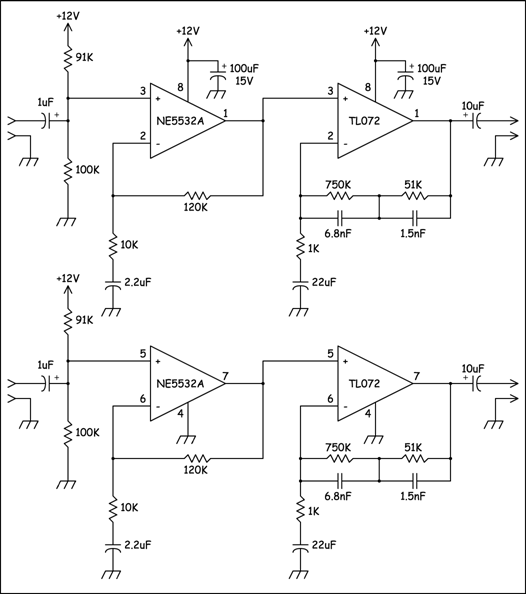
RIAA Corrector

To listen to old vinyl LPs with proper sound quality using a dynamic cartridge, a circuit known as an RIAA corrector is required. This circuit is commonly found in older amplifiers but is not typically included in modern home cinema equipment or amplifiers available today. Additionally, if there is a desire to archive vinyl LPs onto a computer, the use of an RIAA corrector is essential. It is beneficial for this corrector to include a small built-in amplifier to drive small control speakers or headphones. The schematic of the circuit designed for this specific purpose includes two sections: the corrector and the amplifier. The corrector section utilizes an NE5532 integrated circuit known for its exceptionally low noise. The resistors used are 1% metal film, rated at 0.6W, while the capacitors in this section should be of 5% tolerance or better, rated for 63-100V. The corrector section provides a direct output to an external amplifier or computer. The amplifier section employs the LM1877 integrated amplifier IC, which delivers 2W per channel to speakers with very low distortion. A potentiometer (P1) is included to control the output power of the amplifier section. The entire circuit operates from an external 12-16V DC power supply. Schematic diagrams, photographs, and PCB layouts of the circuitry are available in the attached documents. A brief mathematical description of the RIAA curve and the fundamentals of LP production can also be found in the accompanying materials.
The RIAA corrector circuit is crucial for proper playback of vinyl records, as it compensates for the frequency response that is altered during the vinyl mastering process. The RIAA equalization curve applies a specific gain and attenuation to different frequency ranges, ensuring that the sound is reproduced accurately when played back. The NE5532 operational amplifier in the corrector section is chosen for its high fidelity and low noise characteristics, making it ideal for this application.
The resistors, rated at 1% tolerance, help maintain consistent performance and minimize signal distortion, while the capacitors, rated at 63-100V, ensure durability and reliability under various operating conditions. The output stage of the corrector directly interfaces with external devices, allowing for seamless integration with modern audio systems or digital recording equipment.
The LM1877 integrated amplifier is designed for low-power applications, making it suitable for driving small speakers or headphones without generating excessive heat or distortion. The inclusion of the potentiometer (P1) allows for user-adjustable volume control, enhancing user experience.
The circuit's power supply requirements of 12-16V DC are standard for many audio applications, providing flexibility in power source options. The availability of schematic diagrams, photographs, and PCB layouts enables users to replicate or modify the design as needed, facilitating further experimentation or customization.
Overall, this RIAA corrector and amplifier circuit serves as an effective solution for both playback and archiving of vinyl records, bridging the gap between vintage audio technology and modern digital formats.To listen old vinyl LP`s in a correct sounding on a sassy with dynamic cartridge you need a circuit, named RIAA corrector. This circuit you can find in old amps, but it isn`t embedded in home cinema equipments or amplifiers can be obtained nowadays.
Also, if you want to archive your vinyl LP`s in your computer it is necessary to use this RIAA corrector. It is good, if this corrector has a little built-in amplifier to drive small control speakers, or earphones. Schematic of circuit built for this express purpose can be found hier. It has two parts, corrector and amplifier part. The corrector part contains NE5532 integrated circuit with extreme small noise. Resistors are 1% metal film 0, 6W types, condenser`s of this corrector section must be 5% or better, 63 - 100 V types.
Corrector section has direct output to external amp or computer. Amplifier section contains integrated amp IC LM1877. It deliver to speakers 2W/channel output power with very low distortion. Potentiometer P1 is for control the output power of the amp section. The whole circuit works from external 12-16 V DC supply. Schematic, photos and PCB layout of the circuitry can be found attached. Short mathematics description of RIAA curve and basics of LP`s production also can be found in attached document. 🔗 External reference
The RIAA corrector circuit is crucial for proper playback of vinyl records, as it compensates for the frequency response that is altered during the vinyl mastering process. The RIAA equalization curve applies a specific gain and attenuation to different frequency ranges, ensuring that the sound is reproduced accurately when played back. The NE5532 operational amplifier in the corrector section is chosen for its high fidelity and low noise characteristics, making it ideal for this application.
The resistors, rated at 1% tolerance, help maintain consistent performance and minimize signal distortion, while the capacitors, rated at 63-100V, ensure durability and reliability under various operating conditions. The output stage of the corrector directly interfaces with external devices, allowing for seamless integration with modern audio systems or digital recording equipment.
The LM1877 integrated amplifier is designed for low-power applications, making it suitable for driving small speakers or headphones without generating excessive heat or distortion. The inclusion of the potentiometer (P1) allows for user-adjustable volume control, enhancing user experience.
The circuit's power supply requirements of 12-16V DC are standard for many audio applications, providing flexibility in power source options. The availability of schematic diagrams, photographs, and PCB layouts enables users to replicate or modify the design as needed, facilitating further experimentation or customization.
Overall, this RIAA corrector and amplifier circuit serves as an effective solution for both playback and archiving of vinyl records, bridging the gap between vintage audio technology and modern digital formats.To listen old vinyl LP`s in a correct sounding on a sassy with dynamic cartridge you need a circuit, named RIAA corrector. This circuit you can find in old amps, but it isn`t embedded in home cinema equipments or amplifiers can be obtained nowadays.
Also, if you want to archive your vinyl LP`s in your computer it is necessary to use this RIAA corrector. It is good, if this corrector has a little built-in amplifier to drive small control speakers, or earphones. Schematic of circuit built for this express purpose can be found hier. It has two parts, corrector and amplifier part. The corrector part contains NE5532 integrated circuit with extreme small noise. Resistors are 1% metal film 0, 6W types, condenser`s of this corrector section must be 5% or better, 63 - 100 V types.
Corrector section has direct output to external amp or computer. Amplifier section contains integrated amp IC LM1877. It deliver to speakers 2W/channel output power with very low distortion. Potentiometer P1 is for control the output power of the amp section. The whole circuit works from external 12-16 V DC supply. Schematic, photos and PCB layout of the circuitry can be found attached. Short mathematics description of RIAA curve and basics of LP`s production also can be found in attached document. 🔗 External reference
